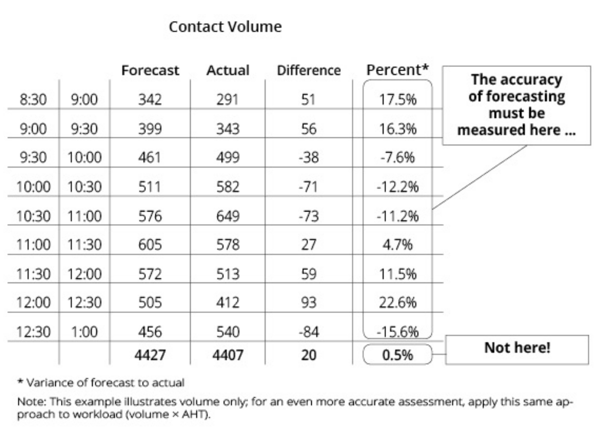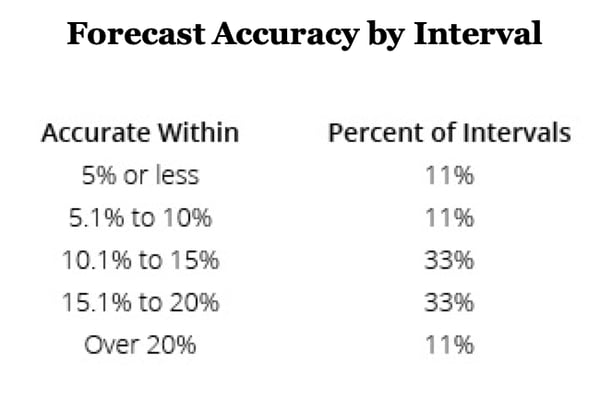Some contact centers consistently achieve high forecast accuracy while others constantly fail. The secret to success is a set of advanced tactics that any planner can apply to maximize the accuracy of their call center forecasting.
(This blog post is adapted from the book “Contact Center Management on Fast Forward: Succeeding in the New Era of Customer Experience” by contact center and workforce management expert Brad Cleveland.)
Measuring Accuracy – Strive for Five
How accurate should your forecast be? Large agent groups (100 or more agents) generally see relatively stable workload patterns and you should strive for plus or minus 5 percent (or better) of workload down to 15 or 30 minute intervals. Small groups (15 or fewer agents) often have more volatile patterns and should shoot for plus or minus 10 percent. Those in between should strive for something close to 5 percent.
This is not to suggest your contact center forecasting can't be better. On the other hand, if you’re just getting started with, say, a small group handling social media interactions, being even remotely close might be a pretty good start! Don’t give up. Make this aspect of planning a priority. Be relentless in your focus until you begin to get your arms around it. Forecasting impacts everything to follow – staffing calculations, schedules and budgets, and, ultimately, the services you deliver.
Measuring Forecast Accuracy

When measuring accuracy, there’s a running debate over whether to use the formula (forecast - actual) / forecast or (forecast - actual) / actual. The important thing is to describe what you calculate: actuals were x% under forecast, or the forecast was y% over actual.
In call center forecasting, it’s essential to look at intervals rather than an average over a day or more. One good alternative is to use mean absolute percent error (MAPE), which is the average of the percentage error regardless of whether it was over or under. The advantage of using MAPE is that it measures how far off the forecast was.
As seen in the table, the day’s forecast was only off by half of a percent (0.5%, or 4,427 forecasted contacts versus 4,407 received). The MAPE is 13.2% (the average of errors by increment with positive and negative signs removed). Another alternative is to summarize the percentage of intervals that fall within various ranges of accuracy (see example). You can summarize a week, month, year or more in this way, and still provide meaningful data.

10 Common Problems (That You Can Avoid!)
The ICMI team often investigates why some call centers have accurate forecasts and others don’t. Ten common problems consistently emerge, and they are summarized here (in no specific order).
In centers with inaccurate forecasts, usually two or three of these issues are most prevalent. The good news? You can avoid these problems, and the remedies in most cases are fairly obvious.
- No systematic process is in place. There are often two erroneous beliefs that some managers use to justify the absence of a systematic forecasting process. Some say, “Our environment is too unpredictable. We’re growing; we’re going omnichannel; we’re introducing new services; you can’t predict social media interactions … there is no way we can produce an accurate forecast.” Just know, there are many centers in similar situations that are enjoying the benefits of respectably accurate forecasts. Others aren’t convinced that forecasting is worth the time. Yep, it takes time—but not nearly as much as some imagine. Further, a good forecast will save a lot of time later on.
- An assumption that “the forecasting software knows best.“ If you have forecasting software or a workforce management system, don’t relinquish decisions to the program, assuming that it knows best. The software doesn’t know what the marketing department is about to do, or that average handling time will be affected by changes you are making to processes or systems. Further, it is important to understand the assumptions your forecasting software is making. Some methods are user-definable. For example, you can program the system to give more weight to recent historical data, or you can tell it to ignore data that varies by more than x% of the norm. It’s a great idea to have the supplier provide a flow chart of the methodology the system is using and decision points where your input is necessary.
- Not forecasting at the agent group level. Even a perfect forecast of the aggregate workload will be of limited use if you route contacts to specialized groups. If you have a group of Mandarin-speaking agents handling services A, B, and C, you will need to forecast contacts from Mandarin-speaking customers who need help with those services.
- The forecast is taken lightly. If the forecast has been wildly inaccurate in the past or if no one understands the assumptions used in the process, it will not be given the prominence it needs in the planning steps to follow.
- Events that should be exceptions become a part of the forecast. Utilities tend to get lots of contacts when storms knock out power, the financial industry gets swamped when confusing tax changes are implemented, and many centers have, on at least one occasion, dealt with contacts from an uncoordinated marketing campaign. (Have your agents ever had to sheepishly ask a customer, “Um, what does the promotion say we are offering?”) Those preparing the forecast have to be aware of the root causes of contacts. That will enable better judgment on what is likely to continue (and therefore should be built into the forecast) versus the exceptions.
- Ongoing communication with other departments doesn’t exist. Most of what happens in a contact center is caused by something going on outside the center. The forecast is doomed if strong ties with other departments don’t exist.
- Planning is done around goals, not reality. If staffing is based on a handling time of four minutes when the actual handling time is more like seven minutes, the resulting schedules will be based on a pipe dream. Maybe improved training, streamlined procedures, and better systems would move things in that direction. But ignoring reality in the planning process is no way to achieve better results or build confidence in the forecast.
- No one is accountable. As vital as a good forecast is, often there is no one who spearheads the effort. Someone needs to be responsible for contact center forecasting. They need to bring the various types of input together, ensure that it is integrated into the forecast, and investigate which assumptions were off when the forecast is not accurate.
- Agents are mixing flexible activities into work modes. If agents are not using work modes consistently, especially after-call work, then accurate forecasting will be elusive.
- Not making the connection with staffing. Forecasts mean nothing unless they are tied to staff and system resources required.
This blog post was adapted from Brad Cleveland's book “Contact Center Management on Fast Forward: Succeeding in the New Era of Customer Experience“. Brad gives a solid introduction for new and advanced planners on how to create accurate forecasts. Among other topics, you will learn how to clean up historical data, how to analyze monthly, weekly and daily contact patterns, how to include insights from marketing campaigns and social media and which software and services to use for advanced forecasting.
👉 Watch the video
Check out our 3-minute video about calculating forecast accuracy.
Did you find the article interesting and would like to share it with your colleagues? Download the article as a PDF.





